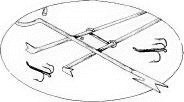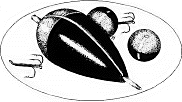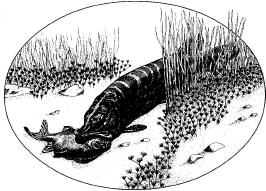In the 1950s I sussed out the method of pike handling that
was to become universal by the 1980s. In the '50s everyone used gags to hold open
the pike's jaw whilst the hooks were removed with a pike disgorger - really just
a large version of an ordinary V disgorger used for small fish. Ray Webb and I
made our own by hammering flat one end of a bicycle spoke! Forceps were just in
use by carp anglers but long-nosed pliers (sometimes with extension bars) were
used by pike anglers if they didn't use V disgorgers.
 I didn't like
gags. I didn't think - and don't think - that they were any more damaging to pike
than large hooks or the perch the pike preyed upon. But they were inefficient.
One of my waters at the time - Eastring Tarn in East Yorkshire - produced for
me a lot of pike from 1/2lb - 3 1/2lbs on lures, and a few bigger fish. Even the
smallest gag available seemed difficult to insert into the jaw, and on small fish
they did do damage. One day I forgot the gag! With a 2lb pike on the bank, and
a lure well inside its mouth. I wondered what to do. In the end, for some reason,
I put my left index finger in under the gill cover and lifted up the pike. I was
staggered to see its mouth open! As soon as I wielded the pliers it closed its
mouth on them, but I quickly learned that a push with the finger opened it again.
Never again did I use gags. It was quite a party trick to demonstrate unhooking
this way, with any size of pike. Anglers in the 1960s who saw it demonstrated
were, firstly, amazed and, secondly, quick to latch on to it. Ray Webb didn't,
as a matter of fact, and he was still using the gag when he retired from angling.
I didn't like
gags. I didn't think - and don't think - that they were any more damaging to pike
than large hooks or the perch the pike preyed upon. But they were inefficient.
One of my waters at the time - Eastring Tarn in East Yorkshire - produced for
me a lot of pike from 1/2lb - 3 1/2lbs on lures, and a few bigger fish. Even the
smallest gag available seemed difficult to insert into the jaw, and on small fish
they did do damage. One day I forgot the gag! With a 2lb pike on the bank, and
a lure well inside its mouth. I wondered what to do. In the end, for some reason,
I put my left index finger in under the gill cover and lifted up the pike. I was
staggered to see its mouth open! As soon as I wielded the pliers it closed its
mouth on them, but I quickly learned that a push with the finger opened it again.
Never again did I use gags. It was quite a party trick to demonstrate unhooking
this way, with any size of pike. Anglers in the 1960s who saw it demonstrated
were, firstly, amazed and, secondly, quick to latch on to it. Ray Webb didn't,
as a matter of fact, and he was still using the gag when he retired from angling.
In
fact I did three things in the 1950s that caused heads to turn. Not only
did I use my new unhooking method, but I used a landing net! And I
put pike back. I'm not saying I invented returning pike, because that was already
happening in the Norfolk Broads and Slapton Ley, for example. But elsewhere in
the country it certainly caused comment. I can tell you! And as for
landing nets, well! Everybody thought landing nets would have holes
bitten in them by the pike (ditto keepnets, which I also used extensively). Pike
anglers today do seem to forget that almost all pike caught in the 1950s were
killed. A few pioneers changed things, slowly, slowly. Nowadays I think it would
be fair to say that most pike are returned.
From the hand-unhooking method
we developed the gloved approach in the 1960s. First of all we used a cloth, then
bought good gloves especially for the job. Unhooking mats were nothing to do with
me - I just used grass, or my rolled out holdall, occasionally a jacket or coat.
Certainly, we never unhooked on hard surfaces at all. I think the netting of pike
and the unhooking systems we devised have been of enormous benefit to the pike
and to pike angling.
Hook-rigs
and the manner of striking also received our attention. Hooks were stupidly large,
and the trace wire at least four times as thick as modern trace wires of the thickest
kind! Ray opted for using only one such treble, or rather small ones. I went for
small multihook rigs (a la Dave Steuart), either two or four depending on the
bait. But by the late 1960s I had concluded that two size 6 or 8 trebles were
really all that was needed to do the job well.
Bill
Chillingworth and I looked hard at the hook rigs, especially the question of a
fixed or moving Ryder on a snap tackle. Fixed hooks were coming into
vogue, encouraged by Richard Walker. Our conclusion after extensive trials was
that the moving Ryder was better on all counts. It is still our view today. The
fixed upper hook serves no useful purpose and is one of those nice-sounding ideas
that is actually wrong.
 I suppose the
other common sight in 1950s piking was that of the pike bung, with a bait fishing
two or three feet below it. And, of course, one to three pilot floats on the line
above the bung. Seems quaint now! The chain of pilot floats was a left over from
the days when lines sank very quickly, i.e. the pilot floats were used to prevent
sinking line close to the bung from fouling the bait. With the advent of nylon
monofil, pilot floats disappeared - except that they made superb pike floats.
I'm very pleased to see that Marvic still do them!
I suppose the
other common sight in 1950s piking was that of the pike bung, with a bait fishing
two or three feet below it. And, of course, one to three pilot floats on the line
above the bung. Seems quaint now! The chain of pilot floats was a left over from
the days when lines sank very quickly, i.e. the pilot floats were used to prevent
sinking line close to the bung from fouling the bait. With the advent of nylon
monofil, pilot floats disappeared - except that they made superb pike floats.
I'm very pleased to see that Marvic still do them!
Anglers
such as Dave Steuart were using paternoster rigs and sliding floats, I think in
the early '60s. By the mid-'60s we were all using them. Once again it was one
of those things that puzzled many Anglers: how come you can fish sixteen feet
of water and your float stay in place! Paternoster rigs really did transform piking,
and the development of good sliding floats was a Godsend. I always made my own
tapered ones out of balsa, but I used round 'pilot' floats as often as not. I
still do use them.
Deadbait
rigs were a headache for a long time. Fred J. Taylor did the pioneer work, but
with the benefit of hindsight those rigs were a bit crude. I never saw Walker's
own pike rigs, but from his descriptions of them, fuse wire and all, they must
have been unnecessarily crude too. Fred's rigs worked quite well, but we modified
them as described in 'Fishing for Big Pike‘. I tried all manner of hook
set-ups in the late 1950s and early 1960s (including, incidentally, barbless hook
rigs!) and eventually settled, by about 1966, for the ordinary simple, snap tackle
(home made, and with the wire about a foot long).
 On a different
tack altogether I developed things which benefited the pike angler rather than
the pike, such as rig bins and roll-up holdalls. Rig bins of this style are still
with us I'm happy to say. They came about in a very strange way. Ray turned up
one Boxing Day with his rigs wound around a Xmas Yule log! I immediately saw the
advantages of this, and two weeks later had made one that fitted neatly into a
dried milk tin. I still have it, and it's as good today as it was then! It's a
very neat way of storing rigs and I'm pleased to see that many firms make them.
(I don't recall ever getting any credit, mind you!).
On a different
tack altogether I developed things which benefited the pike angler rather than
the pike, such as rig bins and roll-up holdalls. Rig bins of this style are still
with us I'm happy to say. They came about in a very strange way. Ray turned up
one Boxing Day with his rigs wound around a Xmas Yule log! I immediately saw the
advantages of this, and two weeks later had made one that fitted neatly into a
dried milk tin. I still have it, and it's as good today as it was then! It's a
very neat way of storing rigs and I'm pleased to see that many firms make them.
(I don't recall ever getting any credit, mind you!).
The roll-up rod
holdalls stemmed from my desire to get fishing quickly at dawn, and from a need
to pack up quickly at dark. No keen anglers like these chores, and elimination
of them became a target. At first Laurie Manns and I rolled our rods up in old
macs! Then we tied a bit of string around the top and bottom. It worked quite
well, but didn't protect the rods very well. If I remember correctly it was Rian
Tingay who had one made out of canvas, and then we all did it. I simply improved
the design. But the idea in the first place came from Laurie and myself. I still
have mine and it is in excellent condition, although I haven't used it recently
very often. That may change now all my Mitchell reels are in good order again!
So there you are! I haven't covered half the things we got up to back in
the '50s but I hope I have painted sufficient of a picture to show you how we
came out of the dark ages of piking and into modern piking. Looking back it is
clear that we improved not only the techniques and tackle but the whole outlook
and philosophy of piking. The question now becomes, where do we go from here?
And then there's the Pike Anglers' Club of Great Britain.



 I didn't like
gags. I didn't think - and don't think - that they were any more damaging to pike
than large hooks or the perch the pike preyed upon. But they were inefficient.
One of my waters at the time - Eastring Tarn in East Yorkshire - produced for
me a lot of pike from 1/2lb - 3 1/2lbs on lures, and a few bigger fish. Even the
smallest gag available seemed difficult to insert into the jaw, and on small fish
they did do damage. One day I forgot the gag! With a 2lb pike on the bank, and
a lure well inside its mouth. I wondered what to do. In the end, for some reason,
I put my left index finger in under the gill cover and lifted up the pike. I was
staggered to see its mouth open! As soon as I wielded the pliers it closed its
mouth on them, but I quickly learned that a push with the finger opened it again.
Never again did I use gags. It was quite a party trick to demonstrate unhooking
this way, with any size of pike. Anglers in the 1960s who saw it demonstrated
were, firstly, amazed and, secondly, quick to latch on to it. Ray Webb didn't,
as a matter of fact, and he was still using the gag when he retired from angling.
I didn't like
gags. I didn't think - and don't think - that they were any more damaging to pike
than large hooks or the perch the pike preyed upon. But they were inefficient.
One of my waters at the time - Eastring Tarn in East Yorkshire - produced for
me a lot of pike from 1/2lb - 3 1/2lbs on lures, and a few bigger fish. Even the
smallest gag available seemed difficult to insert into the jaw, and on small fish
they did do damage. One day I forgot the gag! With a 2lb pike on the bank, and
a lure well inside its mouth. I wondered what to do. In the end, for some reason,
I put my left index finger in under the gill cover and lifted up the pike. I was
staggered to see its mouth open! As soon as I wielded the pliers it closed its
mouth on them, but I quickly learned that a push with the finger opened it again.
Never again did I use gags. It was quite a party trick to demonstrate unhooking
this way, with any size of pike. Anglers in the 1960s who saw it demonstrated
were, firstly, amazed and, secondly, quick to latch on to it. Ray Webb didn't,
as a matter of fact, and he was still using the gag when he retired from angling. I suppose the
other common sight in 1950s piking was that of the pike bung, with a bait fishing
two or three feet below it. And, of course, one to three pilot floats on the line
above the bung. Seems quaint now! The chain of pilot floats was a left over from
the days when lines sank very quickly, i.e. the pilot floats were used to prevent
sinking line close to the bung from fouling the bait. With the advent of nylon
monofil, pilot floats disappeared - except that they made superb pike floats.
I'm very pleased to see that Marvic still do them!
I suppose the
other common sight in 1950s piking was that of the pike bung, with a bait fishing
two or three feet below it. And, of course, one to three pilot floats on the line
above the bung. Seems quaint now! The chain of pilot floats was a left over from
the days when lines sank very quickly, i.e. the pilot floats were used to prevent
sinking line close to the bung from fouling the bait. With the advent of nylon
monofil, pilot floats disappeared - except that they made superb pike floats.
I'm very pleased to see that Marvic still do them! On a different
tack altogether I developed things which benefited the pike angler rather than
the pike, such as rig bins and roll-up holdalls. Rig bins of this style are still
with us I'm happy to say. They came about in a very strange way. Ray turned up
one Boxing Day with his rigs wound around a Xmas Yule log! I immediately saw the
advantages of this, and two weeks later had made one that fitted neatly into a
dried milk tin. I still have it, and it's as good today as it was then! It's a
very neat way of storing rigs and I'm pleased to see that many firms make them.
(I don't recall ever getting any credit, mind you!).
On a different
tack altogether I developed things which benefited the pike angler rather than
the pike, such as rig bins and roll-up holdalls. Rig bins of this style are still
with us I'm happy to say. They came about in a very strange way. Ray turned up
one Boxing Day with his rigs wound around a Xmas Yule log! I immediately saw the
advantages of this, and two weeks later had made one that fitted neatly into a
dried milk tin. I still have it, and it's as good today as it was then! It's a
very neat way of storing rigs and I'm pleased to see that many firms make them.
(I don't recall ever getting any credit, mind you!).